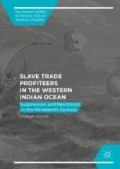Abstract
This chapter shows how the role of the East African coastal urban society in the slave distribution system of the western Indian Ocean was transformed. For many years, this society was an emporium within the slave distribution system. From the 1820s, the successful transplanting of cloves and the rise of a plantation economy in Zanzibar saw the region develop a demand for slaves of its own. First, the chapter examines the progress of this transformation. In exchange for depopulation in mainland East Africa, the urban coastal society held a large number of slaves, thus becoming a slave-owning society. From the mid-nineteenth century, frequent slave raids from Zanzibar were reported. It had become a new slave ground.
Author information
Authors and Affiliations
Corresponding author
Rights and permissions
Copyright information
© 2017 The Author(s)
About this chapter
Cite this chapter
Suzuki, H. (2017). The Transformation of East African Coastal Urban Society with Regard to the Slave Distribution System. In: Slave Trade Profiteers in the Western Indian Ocean . Palgrave Series in Indian Ocean World Studies. Palgrave Macmillan, Cham. https://doi.org/10.1007/978-3-319-59803-1_6
Download citation
DOI: https://doi.org/10.1007/978-3-319-59803-1_6
Published:
Publisher Name: Palgrave Macmillan, Cham
Print ISBN: 978-3-319-59802-4
Online ISBN: 978-3-319-59803-1
eBook Packages: HistoryHistory (R0)

